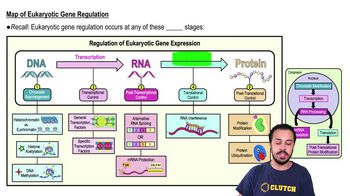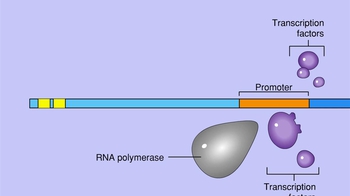Table of contents
- 1. Introduction to Biology2h 42m
- 2. Chemistry3h 40m
- 3. Water1h 26m
- 4. Biomolecules2h 23m
- 5. Cell Components2h 26m
- 6. The Membrane2h 31m
- 7. Energy and Metabolism2h 0m
- 8. Respiration2h 40m
- 9. Photosynthesis2h 49m
- 10. Cell Signaling59m
- 11. Cell Division2h 47m
- 12. Meiosis2h 0m
- 13. Mendelian Genetics4h 44m
- Introduction to Mendel's Experiments7m
- Genotype vs. Phenotype17m
- Punnett Squares13m
- Mendel's Experiments26m
- Mendel's Laws18m
- Monohybrid Crosses19m
- Test Crosses14m
- Dihybrid Crosses20m
- Punnett Square Probability26m
- Incomplete Dominance vs. Codominance20m
- Epistasis7m
- Non-Mendelian Genetics12m
- Pedigrees6m
- Autosomal Inheritance21m
- Sex-Linked Inheritance43m
- X-Inactivation9m
- 14. DNA Synthesis2h 27m
- 15. Gene Expression3h 20m
- 16. Regulation of Expression3h 31m
- Introduction to Regulation of Gene Expression13m
- Prokaryotic Gene Regulation via Operons27m
- The Lac Operon21m
- Glucose's Impact on Lac Operon25m
- The Trp Operon20m
- Review of the Lac Operon & Trp Operon11m
- Introduction to Eukaryotic Gene Regulation9m
- Eukaryotic Chromatin Modifications16m
- Eukaryotic Transcriptional Control22m
- Eukaryotic Post-Transcriptional Regulation28m
- Eukaryotic Post-Translational Regulation13m
- 17. Viruses37m
- 18. Biotechnology2h 58m
- 19. Genomics17m
- 20. Development1h 5m
- 21. Evolution3h 1m
- 22. Evolution of Populations3h 52m
- 23. Speciation1h 37m
- 24. History of Life on Earth2h 6m
- 25. Phylogeny2h 31m
- 26. Prokaryotes4h 59m
- 27. Protists1h 12m
- 28. Plants1h 22m
- 29. Fungi36m
- 30. Overview of Animals34m
- 31. Invertebrates1h 2m
- 32. Vertebrates50m
- 33. Plant Anatomy1h 3m
- 34. Vascular Plant Transport1h 2m
- 35. Soil37m
- 36. Plant Reproduction47m
- 37. Plant Sensation and Response1h 9m
- 38. Animal Form and Function1h 19m
- 39. Digestive System1h 10m
- 40. Circulatory System1h 57m
- 41. Immune System1h 12m
- 42. Osmoregulation and Excretion50m
- 43. Endocrine System1h 4m
- 44. Animal Reproduction1h 2m
- 45. Nervous System1h 55m
- 46. Sensory Systems46m
- 47. Muscle Systems23m
- 48. Ecology3h 11m
- Introduction to Ecology20m
- Biogeography14m
- Earth's Climate Patterns50m
- Introduction to Terrestrial Biomes10m
- Terrestrial Biomes: Near Equator13m
- Terrestrial Biomes: Temperate Regions10m
- Terrestrial Biomes: Northern Regions15m
- Introduction to Aquatic Biomes27m
- Freshwater Aquatic Biomes14m
- Marine Aquatic Biomes13m
- 49. Animal Behavior28m
- 50. Population Ecology3h 41m
- Introduction to Population Ecology28m
- Population Sampling Methods23m
- Life History12m
- Population Demography17m
- Factors Limiting Population Growth14m
- Introduction to Population Growth Models22m
- Linear Population Growth6m
- Exponential Population Growth29m
- Logistic Population Growth32m
- r/K Selection10m
- The Human Population22m
- 51. Community Ecology2h 46m
- Introduction to Community Ecology2m
- Introduction to Community Interactions9m
- Community Interactions: Competition (-/-)38m
- Community Interactions: Exploitation (+/-)23m
- Community Interactions: Mutualism (+/+) & Commensalism (+/0)9m
- Community Structure35m
- Community Dynamics26m
- Geographic Impact on Communities21m
- 52. Ecosystems2h 36m
- 53. Conservation Biology24m
16. Regulation of Expression
Introduction to Eukaryotic Gene Regulation
Problem 8`
Textbook Question
Which of the following statements about the DNA in one of your brain cells is true?
a. Most of the DNA codes for protein.
b. The majority of genes are likely to be transcribed.
c. It is the same as the DNA in one of your liver cells.
d. Each gene lies immediately adjacent to an enhancer.
 Verified step by step guidance
Verified step by step guidance1
Understand that DNA is the same in all cells of an organism, meaning the DNA in brain cells is identical to that in liver cells. This is due to the fact that all cells originate from a single fertilized egg and contain the same genetic information.
Recognize that not all DNA codes for proteins. In fact, only a small portion of the DNA in human cells is made up of protein-coding genes. The rest includes non-coding regions, regulatory sequences, and other elements.
Consider that not all genes are actively transcribed in every cell. Gene expression is regulated, and only a subset of genes is transcribed in any given cell type, depending on the cell's function and needs.
Enhancers are regulatory DNA sequences that can increase the transcription of genes. However, they do not necessarily lie immediately adjacent to the genes they regulate. Enhancers can be located at varying distances from their target genes, sometimes even thousands of base pairs away.
Based on these considerations, evaluate each statement to determine which one accurately reflects the nature of DNA in brain cells compared to other cell types in the body.
 Verified video answer for a similar problem:
Verified video answer for a similar problem:This video solution was recommended by our tutors as helpful for the problem above
Video duration:
50sPlay a video:
Was this helpful?
Key Concepts
Here are the essential concepts you must grasp in order to answer the question correctly.
DNA Consistency Across Cells
In multicellular organisms, all somatic cells contain the same DNA sequence, regardless of their function or location in the body. This means that the DNA in a brain cell is identical to the DNA in a liver cell. The differences in cell function arise from the expression of different sets of genes, not from differences in the DNA sequence itself.
Recommended video:
Guided course

Organization of DNA in the Cell
Gene Expression and Transcription
Not all genes in a cell are actively transcribed at any given time. Gene expression is regulated so that only the necessary genes for a cell's function are transcribed. In specialized cells like brain cells, only a subset of genes is transcribed to produce the proteins needed for specific cellular functions, while other genes remain inactive.
Recommended video:
Guided course

Introduction to Regulation of Gene Expression
DNA Coding for Proteins
In eukaryotic genomes, only a small fraction of the DNA actually codes for proteins. The majority of the DNA consists of non-coding regions, including introns, regulatory sequences, and repetitive elements. These non-coding regions play crucial roles in gene regulation and genome stability, but do not directly code for proteins.
Recommended video:
Guided course

Genetic Code

 3:47m
3:47mWatch next
Master Introduction to Eukaryotic Gene Regulation with a bite sized video explanation from Jason
Start learning



